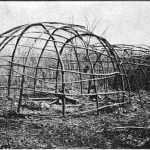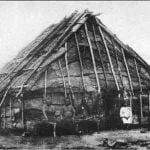It is not the purpose of the present sketch to trace the early migrations of the Sauk and Fox tribes, or to refer to their connection, linguistically or socially. However, it is evident their villages were similar in appearance, and both had two distinct forms of habitations which were occupied during different seasons of the year. The summer villages of both tribes consisted of bark houses, and near by were gardens in which they raised corn, squashes, beans, and some tobacco, but with the coming of autumn the families scattered and sought the more protected localities where game was to be secured, and there erected the dome-shaped, mat-covered lodge, resembling the structures of other tribes of the region.

The middle of the eighteenth century found the two tribes established in villages near the mouth of Rock River, on the left bank of the Mississippi, in the present Rock Island County, Illinois. Here they were visited by Long and his small party August 1, 1817, at which time the Fox settlement “containing about thirty cabins, with two fires each;” stood on the left bank of Rock River, at its junction with the Mississippi. The Sauk village was 2 miles up Rock River and consisted “of about one hundred cabins, of two, three, and in some instances, four fires each,” and it was, so Long wrote, “by far the largest Indian village situated in the neighborhood of the Mississippi between St. Louis and the Falls of St. Anthony.” 1 This was the birthplace, in the year 1767, of the great Sank leader Black Hawk. At the time of Long’s visit the people of the two villages had several hundred acres of corn. “partly in the low ground and extended up the slopes of the bluffs.” and were in a very prosperous condition.
The village was destroyed by the militia June 15, 1831, and those who escaped soon after crossed the Mississippi. In 1837, having ceded their hunting grounds in Iowa to the Government. they removed to a tract in Kansas beyond the Missouri, where they continued to reside for some 20 years as practically one tribe. Later the majority of the Foxes returned to Iowa and secured a small tract of land near Tama, in Tama County, on the left bank of Iowa River, where a mixed group continues to dwell. In 1867 the remaining Sauk ceded their lands in Kansas and removed to the Indian Territory.

As already mentioned, the tribes erected two distinct types of habitations. The mat covered lodge is shown in plate 18. The bare frames, ready for the mat coverings, are indicated in a, while the completed structure is represented in b of the same plate. Both photographs were made near Tama within the past few years.
During the summer of 1820 Schoolcraft was on the upper Mississippi and stopped at the village of the Sioux chief “La Petit Corbeau,” which stood on the bank of the river a few miles below the present city of St. Paul. He was conducted to the lodge of the chief, which, so he wrote, ” is spacious, being about sixty feet in length by thirty in width-built in a permanent manner of logs, and covered with bark.”, 2 A few days later, on August 6, 1820, he left the mouth of the Wisconsin, passed the mouth of Turkey River, which joins the Mississippi from the west, and 1 mile below the mouth of Turkey River arrived at a Fox village which stood on the left bank of the Mississippi. This would have been near the present village of Cassville, Grant County, Wisconsin. Here were twelve lodges, “large, and built of logs, in the same substantial manner practiced among the Narcotah bands.” This refers to the village of La Petit Corbeau and others which he had recently visited. And continuing the narrative, “The cause of their being now deserted, is the fear entertained of an attack from the Sioux, in retaliation for the massacre lately perpetrated upon the banks of the St. Peter’s. The desertion appears to have taken place after they had planted their corn, and from the order, in which the village is left, it may be concluded that, its re-occupation is kept in view. I found several small gardens and corn fields adjoining the village, in which squashes, beans, and pumpkins were abundant, but the corn had been nearly all destroyed, probably by wild animals. Walking back from the river half a mile, I was surprised to find an extensive field of water and musk-melons, situated in the midst of a grove of small, scattering trees, but without any enclosure. Some of the fruit had been destroyed by animals, but a great abundance still remained.” 3

The preceding references would seem to apply to summer habitations, as distinguished from the mat-covered structures already mentioned. The descriptions are rather vague, and the lodges encountered by Schoolcraft may have been similar in form to that shown in plate 19. This most interesting and valuable photograph Was made in the Indian Territory probably 40 years or more ago. and represents a rather large dwelling. It shows clearly the manner in which sheets of bark were placed and secured to serve as roof and sides, and in this instance the bark appears to be that of the elm.
Interesting notes on the manners and ways of life of the Sauk and Foxes just a century ago are to be found in a communication from Maj. M. Marston. of the Fifth Infantry, to Morse. Marston was commanding officer at Fort Armstrong, from which place the letter was written during the month of November 1820. At that time the Fox village standing on the bank of the Mississippi, opposite Fort Armstrong, consisted of “thirty-five permanent lodges,” and this may refer to the type of structures shown in plate 19. As Marston then wrote: ” There is also a small Sauk village of five or six lodges on the west bank of the Mississippi, near the mouth of Des Moin river, and below Fort Edwards; and a Fox village near the lead mines (about a hundred miles above this place,) of about twenty lodges; and another near the month of the Wapsipinica of about ten lodges.” Thus the villages and camps of the two tribes were to have been seen on both banks of the Mississippi, but undoubtedly the greater part of their hunting was done westward from the river, within the present State of Iowa. A century ago the people of the village would leave “as soon as their corn, beans, &c., are ripe and taken care of, and their traders arrive and give out their credit, (or their outfits on credit,) and go to their wintering grounds; it being previously determined in council, on what particular ground each party shall hunt. The old men, women, and children, embark in canoes; the young men go by land with their horses; on their arrival, they immediately commence their winter’s hunt, which lasts about three months.” The traders would follow and remain in convenient places. During the winter most of the Indians would pay their debts, get many necessary articles, and at the same time reserve the more valuable skins. These. “such as beaver, otter, &c., they take home with them to their villages, and dispose of for such articles as they may afterwards find necessary.” The winter of 1819-20 was evidently a very prosperous one for the two tribes as well as for the traders, and Marston wrote: “Thesse traders, including the peltries received at the United States Factory, near Fort Edwards, collected of the Sauk and Fox Indians during this season, nine hundred and eighty packs. They consisted of 2,760 beaver skins; 922 Otter; 13,440 Raccoon; 12,900 Musk Rat; 500 Mink; 200 Wild Cat; 680 Bear Skins, 28,600 Deer. Whole number, 60,082.”
At the close of the winter hunt “they return to their villages, in the month of April, and after putting their lodges in order, commence preparing the ground to receive the seed. The number of acres cultivated by that part of the two nations, who reside at their villages in this vicinity, is supposed to be upwards of three hundred. They usually raise from seven to eight thousand bushels of corn, besides beans, pumpkins, melons, &c. About one thousand bushels of the corn they annually sell to traders and others; the remainder (except about five bushels for each family, which is taken with them,) they put into bags, and bury in holes dug in the ground, for their use in the spring and summer. The labor of agriculture is confined principally to the women, and this is done altogether with a hoe. In June, the greatest part of the young men go out on a summer hunt, and return in August. While they are absent the old men and women are collecting rushes for mats, and bark to make into bags for their corn, &c.
“The women usually make about three hundred floor mats every summer. The twine which connects the rushes together, is made either of basswood bark, after being boiled and hammered, or the bark of the nettle; the women twist or spin it by rolling it on the knee with the hand.” 4 Some men, as well as women, of these tribes are often employed in and about the lead mines on the Mississippi, not far from their villages.
The customs of the tribes, as related in the preceding notes, their hunts away from the villages during certain seasons of the year, their return to plant and care for their fields and gardens, and the placing of the surplus grain in caches, had probably been followed by native tribes of the Mississippi Valley and adjacent regions for generations before the coming of the Europeans.
Citations:
- Long, Stephen H., Voyage in a Six-Oared skiff to the Falls of Saint Anthony in 1817. In Collections Minnesota Historical Society, Vol. II, pt. 1. 1860, pp. 68-69. First Expedition. See James, Edwin. Account of an Expedition from Pittsburgh to the Rocky Mountains, performed in the years 1819 and 1820. Philadelphia, 1823. 2 vols.. Second Expedition. See Keating, W. H. Narrative of an Expedition to the Source of St. Peter’s River, under command of Stephen H. Long. Philadelphia, 1824. 2 vols.[↩]
- Schoolcraft, Henry R., Narrative Journal of Travels . . . in the year 1820. Albany, 1821, p. 318.[↩]
- Schoolcraft, Henry R., Narrative Journal of Travels . . . in the year 1820. Albany, 1821, pp. 340-341.[↩]
- Morse, Jedidiah, A Report to the Secretary of War of the United States, on Indian Affairs. New Haven, 1822, App., pp. 124-127.[↩]
